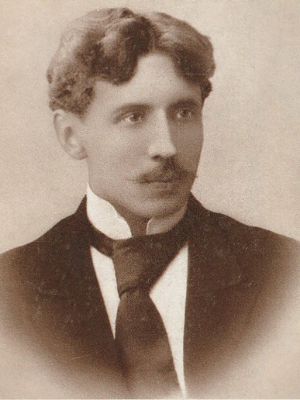
Mikalojus Konstantinas Čiurlionis © akg-images_fine art images
Mikalojus Konstantinas Čiurlionis
A small number of extraordinarily multi-talented composers with additional artistic or literary leanings have periodically cropped up during the course of music history. One of the most prominent figures of this exclusive circle is the Lithuanian composer Mikalojus Konstantinas Čiurlionis (1875 – 1911) who displayed such an equally balanced aptitude for both music and art that neither of his talents could be said to outshine the other. As a painter, Čiurlionis can be identified as a Symbolist bordering on an abstract style, and as a composer of the Late Romantic period and ‘fin de siècle’. His artistic and musical output is phenomenal within both fields: Čiurlionis amassed a body of around 300 paintings and prints and approximately 400 compositions, a large proportion of which were piano works, in which the free prelude form clearly dominates. The composer was a central figure in the creation of a national Lithuanian style whose significance was largely parallel to the roles played by Jean Sibelius for Finnish music and Edward Grieg for Norwegian music, even though Lithuania was still part of the Russian Empire during Čiurlionis’ lifetime.
Čiurlionis was born in 1875 in the small Lithuanian town of Varėna where his father was employed as an organist. Although Čiurlionis’ artistic talent was recognised at an early age, it was his musical education which initially took centre stage. From 1893 to 1899, he attended a music school within the grounds of an aristocratic landowner who subsequently made it possible for Čiurlionis to study at the music conservatoire in Warsaw. Shortly after concluding his studies, Čiurlionis composed the orchestral work ‘In the Forest’ in 1901 – 02 in which the composer’s individual artistic personality could already be discerned/recognised. The composer continued his musical studies in Leipzig, Germany, for an additional year. On his return to Warsaw, Čiurlionis took professional drawing lessons and attended the newly opened art school from 1904 onwards. He was soon exhibiting his paintings in a number of successful public exhibitions in Warsaw and took part in the First Exhibition of Lithuanian Art in Vilnius (1906 – 07).
Čiurlionis settled in Vilnius in 1907 and in the same year first encountered the writer Sofija Kymantaitė who would play such a great part in his life. Under her influence, the artist formerly oriented towards Polish culture began to examine his Lithuanian roots and became the spokesperson for Lithuanian national art. The couple married in 1909 and were based temporarily in St Petersburg after their marriage. Towards the end of the year, the previously restlessly active artist was beginning to display signs of exhaustion. Despite an extended period in a sanatorium, there was no improvement in Čiurlionis’ health and he died in April 1911. Initially, it was the paintings of the artist which were the main focus of his reception, but in the meantime, there has been increasing interest in his compositional works.
As of: November 2024